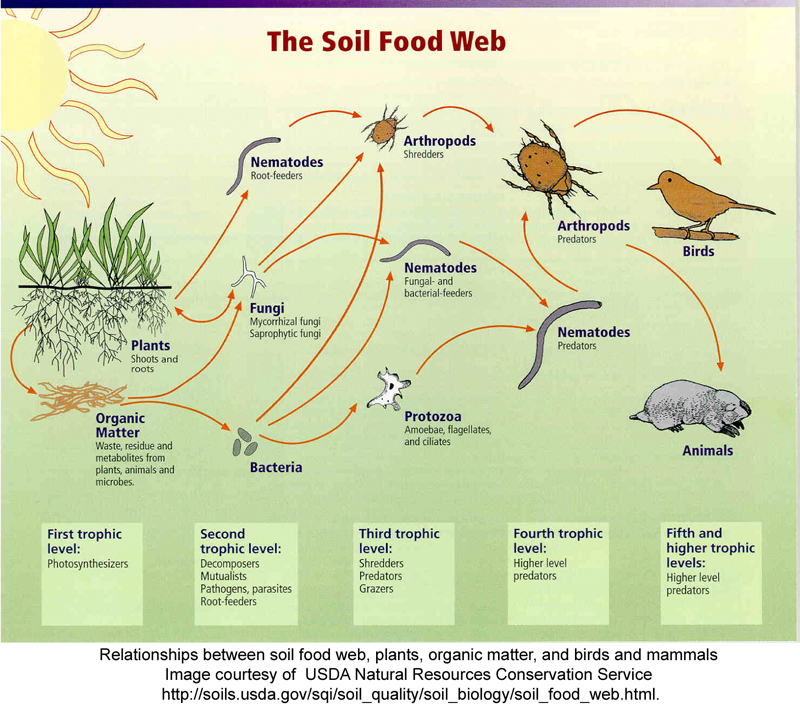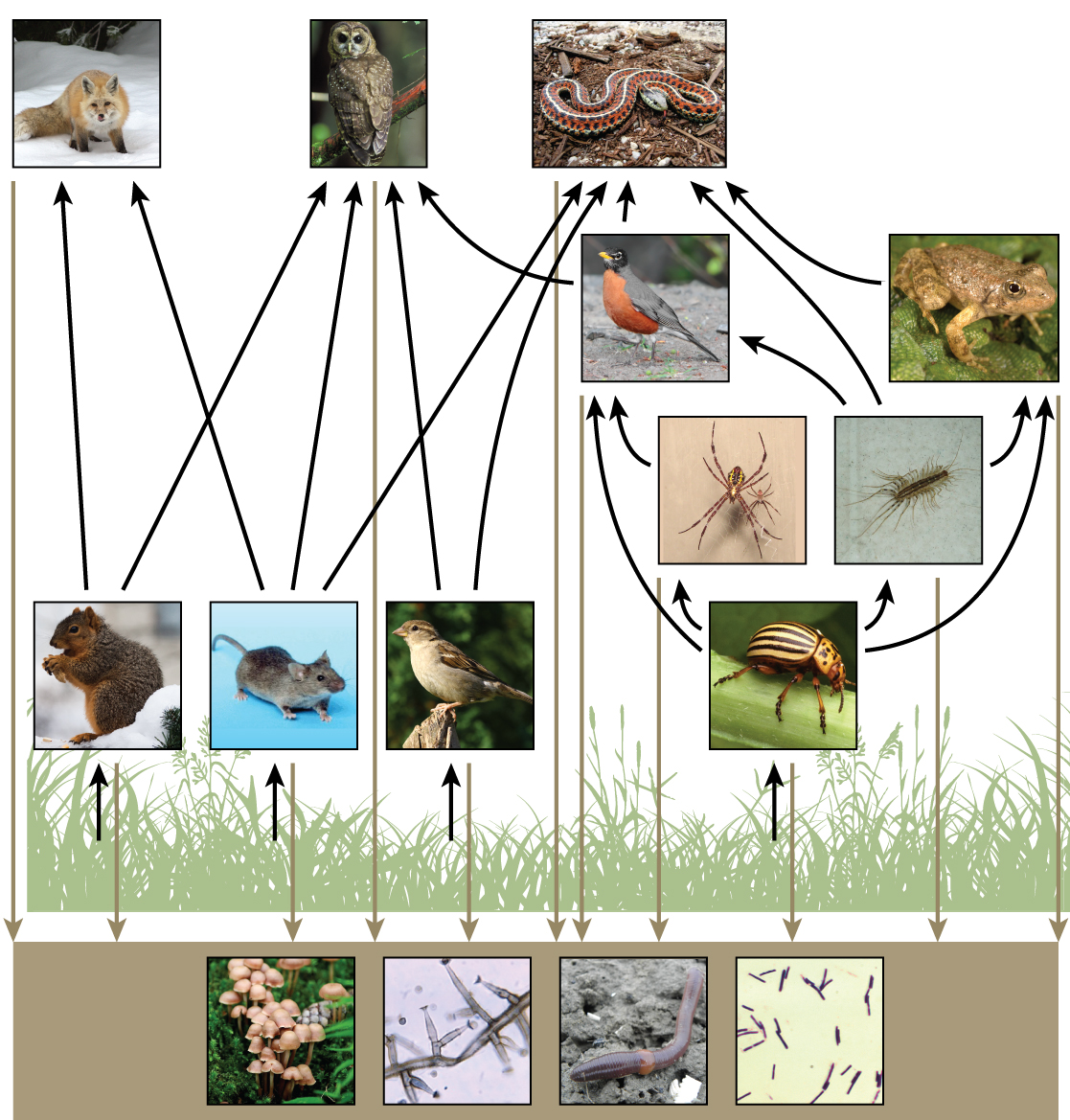unlearning the food chain
In biology/ecology/etc, there's a tendency for the early, simplified versions of concepts to be neat little chains or sequences of one thing --> another thing.
you may know the deal here:
sun --> grass --> grasshopper --> mouse --> hawk. et cetera.
If we're talking about agriculture or hunting (anything where a person gets meat, I guess), then we get things like sun --> grass --> cow/deer --> human. We are the apex, the end-point of these chains, and this is often spun into a kind of hierarchy ... we are dominant over things that we eat.
but: Looking at this neat little chain for a bit longer, it falls to pieces. This is typical for the very-simple ways that early concepts are taught; think about how kids are taught mathematics, versus advanced mathematics ... unfortunately these "food chains" become a kind of moral/philosophical stomping ground which cements them in the social consciousness more than they deserve.
There is so much that the "food chain" fails to capture. Biting bugs and parasites like mosquitoes and ticks will hop onto wolves and deer alike, and those same bugs will get eaten by birds. Bugs, fungi, and small carnivores frolic in carcasses, not really caring if the carcass is the body of a lion or a zebra. Deer chew bones. It's entirely feasible that herbivores can accidentally eat insects (insects appear to have methods of avoiding this fate). Creatures of all sorts eat our dead skin, whether in shed flakes (e.g. dust mites) or still on our bodies (e.g. Demodex face mites). They don't care if we view ourselves as apex predators, the pinnacle of evolution ... if we call ourselves kings, presidents, emperors. To them we're just dead skin.
...
The food web is a more complex kind of diagram which has more than a single trajectory, but there is a persistence of the idea of energy flowing from plants, to herbivores, to carnivores. Within the web, animals are grouped by trophic levels that serve as shorthand for what feeding behaviors they perform, which is useful for figuring out how species interact (e.g. two predators that hunt herbivores may not hunt each other but may fight over the same food). Trophic levels are useful but always with the caveat that things are muddier in real life. In reality, at basically every step of the way there's some kind of tiny critter that's siphoning off a little bit of bodily fluid here and there. Sometimes a lot of bodily fluid, lethal amounts. This gets emitted in most cases.

like in the image above: pretty nice, easy to read, gives a shout-out to invertebrates and fungi and the creepy-crawlies that people love to pretend don't exist. Nevertheless, Despite having good representation of invertebrate (nematodes/arthropods) and nonanimal-nonplant life (bacteria, protozoa, fungi), the exact kind of guys who parasitize & decompose, parasitism & decomposition only get mentioned in the "Second trophic level" box (& apparently in relation to only plant hosts). Like... jeez, that's just mean, I'm glad ticks & leeches and stuff don't know how to use computers.
there are some that're a bit more respectful to our underappreciated cousins:

this second image mentions decomposers, everyone celebrate 🎉 🎉 🎉 !!! They didn't mention parasites here either, though. it says: Worry not, Fox, Owl, & Snake, the Lower Trophic Levels will only take your hard-earned energy once you've passed away. Hm.
In any case, one can imagine if the trajectories of the food chain/web are pipes with directional flow, then there are a whole lot of species who poke a hole in the pipe and provide access to its water without having to fight for a spot at the pipe's output. by this I mean that mosquitoes, ticks, etc, they take energy & elements from animals that would normally remain "trapped" in that animal's body until it dies and rots. They can draw energy backwards by drinking the blood of a "higher level" wolf, and then getting eaten by a "lower level" frog.
why don't we acknowledge them properly? Lots of potential reasons to point out. There is the issue that if you start drawing lots of arrows between species eating one another, you'll end up with something looking like a tangled skein that makes no sense at all. But it'd be possible to make food webs larger, or maybe have asterisks, daggers, etc & footnotes for notable places where little beasties play prominent roles.
I think it's likely related to the mythologies we tell ourselves in the sort of, Western / Global North "culture" ... hierarchies are natural, we're supposed to be on top, etc etc. Individual "fitness" is put on a pedestal and very misinterpreted, so animals with incredible strength, size, and charisma are elevated above their brethren (think about Western portrayals lions, tigers, wolves, bears, bulls, versus hummingbirds, butterflies, rabbits, rats,) ... carnivory is macho, and if an animal isn't a carnivore it can at least be worthy of respect due to its ability to fight carnivores and usually being male (bulls & rams & boars are cool, cows & ewes & sows aren't so much). There are a lot of cultural hangups, with some men feeling that vegetarianism is emasculating (???) and Western conservationists assuming that any/all hunting is symptomatic of machismo & desire to assert domination over nonhuman subjects. We fear the apex-predator in a respect-fear way, like a powerful warrior ... then the tiny venomous bug, as we do with a two-faced traitor ... & find herbivore-fears laughable even when cows and hippos and moose will more than easily break the human body. "Nature" is the world in which humans have always been immersed, so ecology's dragging along millennia of natural metaphors that make people cling to simplified (or even outright wrong) information.
what I'm saying is that portraying interactions in nature as a trajectory of Stuff accumulating to the Guys On Top via transfer from an inferior group to the next group up on the ladder, is, it's very in-line with the way the Guys On Top tell us that all interactions work naturally. Swallow this pill, it'll hurt you and benefit me, but It's All Natural™ so it must be good!
I'm not being hyperbolic here, promise, you'll see people who've bought into the "food chain" wholesale All over the dang place, even if from a philosophical standpoint only. Alpha Males, top-dog of the apex predator caste. Carnivore Diets, against emasculated Soyboys (who eat vegetables instead of meat). Vegans pushing back against the carnivores by pointing out bulls, bison, gorillas, other large-body herbivores that could thrash a would-be predator. & the tiny, diligent, ever-present creatures that Robin-Hood bits of the higher trophic levels back to the lower, they are ever unnoticed.
the humans that are the "Alphas" , the "Apex Predators" , & who insist as such, they hate when they are forced to notice those unnoticed forces. There is a lot to say here and I don't know if I have the words to say it; luckily, it's not just me who seeks to talk about it. A brilliant tumblr blog, fatehbaz, has made a few posts with excerpts from Rohan Deb Roy's 2020 White ants, empire, and entomo-politics in South Asia ... the white ants ate paper (the body tissue of imperialism) with glee, metamorphosing from the trodden-underfoot ant to a scourge against the British empire itself. The tiny ants were causing problems for the British, which they "shouldn't be doing", because they're ants ... things like ticks and worms "shouldn't" be having a profound impact on ecology, implies the Men On Top, because they are the trophic-level underclass, and the underclass cannot be portrayed as a powerful force.
so the US senator sees the diagram that has all the lesser animals portrayed as a feast for the Wolf, and he knows he is a Wolf. He looks in the mirror & says that he's the top of the food chain. a few weeks later, he develops anaemia from the fleas that his dog brought into his house.
They don't seem to care what he thinks he is.
...
thanks for reading!🪱🦀
Atom feed ; RSS feed
check out my reading list while you're here :)